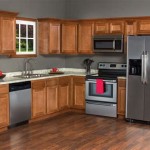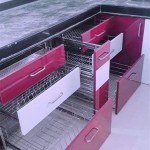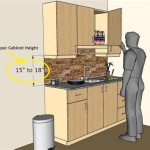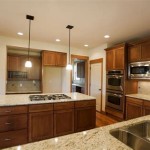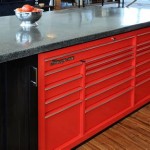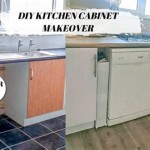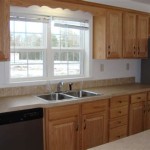How To Adjust Self-Closing Hinges On Kitchen Cabinets
Self-closing hinges are a common feature in modern kitchen cabinets, providing convenience and preventing cabinets from being left ajar. Over time, these hinges can become misaligned or lose their effectiveness, resulting in doors that slam shut, don't close completely, or hang unevenly. Adjusting these hinges is a manageable task that can significantly improve the functionality and aesthetics of a kitchen. This article provides a comprehensive guide on how to adjust self-closing hinges on kitchen cabinets effectively.
Before commencing any adjustments, it is crucial to understand the different types of self-closing hinges commonly found in kitchen cabinets. Euro-style hinges, also known as concealed hinges, are the most prevalent type. These hinges are hidden when the cabinet door is closed, offering a clean and modern look. They typically feature multiple adjustment screws that allow for fine-tuning of the door's position. Another type is the surface-mounted hinge, which is visible when the door is closed. While less common in modern kitchens, they can still be found, particularly in older homes. The adjustment process may differ slightly depending on the hinge type, but the fundamental principles remain the same.
The tools needed for adjusting self-closing hinges are relatively simple and readily available. A Phillips head screwdriver is the most essential tool, as the majority of adjustment screws are Phillips head. A flathead screwdriver might be required for some older or less common hinge types. A level is necessary to ensure the cabinet door is plumb and a measuring tape can be helpful for consistent alignment. Safety glasses are also recommended to protect the eyes from any debris or accidental slippage of tools. With the appropriate tools in hand, the adjustment process can be approached systematically and efficiently.
Identifying the Adjustment Needs
The first step in adjusting self-closing hinges is to accurately identify the specific issues that need to be addressed. Common problems include doors that slam shut too forcefully, doors that don't close completely, doors that rub against the cabinet frame, and doors that are misaligned, creating uneven gaps between doors or with the surrounding cabinet frames. A thorough inspection of each door is necessary to pinpoint the exact nature of the problem. Opening and closing the doors slowly while observing their movement can reveal subtle misalignments or binding issues.
For doors that slam shut, the self-closing mechanism is likely too strong. This often indicates that the hinge tension is set too high. Conversely, if the doors do not close completely and require a manual push to latch, the self-closing mechanism might be too weak or obstructed. Obstructions can include grease buildup, debris, or a malfunctioning hinge mechanism. Addressing these issues requires a different approach compared to misalignment problems.
Misalignment can manifest in various ways. A door may be too high or too low, causing it to rub against the cabinet frame or adjacent doors. It may also be too far forward or backward, creating an uneven gap between the door and the cabinet frame. Lateral misalignment can cause the door to swing at an angle, making it appear crooked. Identifying the specific direction and degree of misalignment is crucial for making accurate adjustments.
In addition to visual inspection, paying attention to the sound the door makes when opening and closing can provide valuable clues. Squeaking or grinding noises often indicate friction between the door and the cabinet frame or a lack of lubrication in the hinge mechanism. Addressing these noises promptly can prevent further damage and extend the lifespan of the hinges.
Adjusting Euro-Style (Concealed) Hinges
Euro-style hinges offer multiple adjustment points, typically three screws per hinge, allowing for precise control over the door's position. These screws control different aspects of the door's alignment: vertical adjustment, horizontal adjustment (also known as side-to-side or depth adjustment), and depth adjustment (which may affect how tightly the door closes). Before making any adjustments, it's important to understand which screw controls which movement. Typically, this information can be found online within the hinge manufacturer specifications, or by carefully experimenting to observe the effect of turning each screw.
To adjust the vertical position of the door, locate the vertical adjustment screw. Loosening this screw allows the door to be moved up or down. Make small adjustments and check the door's alignment after each adjustment. Once the door is in the desired vertical position, tighten the screw securely. Ensure that both hinges on the door are adjusted equally to maintain a consistent gap along the top and bottom of the door.
Horizontal adjustment controls the side-to-side position of the door, affecting how much the door overlaps the cabinet frame. The horizontal adjustment screw typically allows the door to be moved closer to or farther away from the side of the cabinet frame. Adjusting this screw can correct situations where the door rubs against the frame or has an uneven gap. As with vertical adjustments, make small changes and check the alignment frequently.
The depth adjustment screw controls how far the door sits from the cabinet frame when closed. Adjusting this screw can correct situations where the door either protrudes too far or sits too deeply within the cabinet opening. This adjustment can also influence the self-closing action. Experiment with this screw to achieve the desired flushness and closing action. Ensure the screws are snug but not overtightened, which can strip the screw heads or damage the cabinet material.
If the self-closing action of the hinge is too strong or too weak, some Euro-style hinges have an adjustment mechanism to control the closing speed. This mechanism might be a small screw or a lever located on the hinge body. Consult the hinge manufacturer's instructions for specific details on how to adjust the closing speed. If no such adjustment is available, replacing the hinge with one that has adjustable closing speed may be necessary.
Adjusting Surface-Mounted Hinges
Surface-mounted hinges, while less common in modern kitchens, still require occasional adjustment to maintain proper door alignment and function. These hinges typically have fewer adjustment options compared to Euro-style hinges, making the adjustment process somewhat simpler but potentially less precise.
The primary method of adjusting surface-mounted hinges involves slightly loosening the screws that secure the hinge to the cabinet door and frame. With the screws loosened, the door can be gently nudged into the desired position. Once the door is aligned correctly, the screws should be tightened securely. This method relies on the inherent flexibility of the hinge and the screw holes to allow for minor adjustments.
If the screw holes have become stripped or enlarged, the screws may not hold the hinge securely. In this case, using longer screws or inserting wooden toothpicks or matchsticks into the screw holes before re-inserting the screws can provide a more secure grip. Alternatively, filling the screw holes with wood filler and then drilling new pilot holes can create a solid base for the screws.
For surface-mounted hinges with a spring-loaded self-closing mechanism, the tension of the spring may be adjustable. Look for a small screw or lever on the hinge body that controls the spring tension. Adjusting this screw or lever can increase or decrease the force with which the door closes. If the spring is broken or worn out, replacing the entire hinge is typically the best solution.
In some cases, the misalignment may be due to warping or sagging of the cabinet door itself. While hinge adjustments can compensate for minor warping, severely warped doors may require shimming or planing to restore their original shape. This is a more advanced repair that may require the assistance of a skilled carpenter. Regular cleaning and lubrication of surface-mounted hinges can also help prevent rust and corrosion, extending their lifespan and ensuring smooth operation.
Following these guidelines will facilitate effectively adjusting the self-closing hinges on kitchen cabinets, leading to improved functionality and visual appeal of the cabinets.

Tec Soft Close Adjustment

How To Adjust Self Closing Kitchen Cabinet Hinges Maintenance

How To Adjust Cabinet Hinges Bob Vila

Replacing Cabinet Hinges With Overlay Self Closing The Palette Muse

Soft Close Hinge Stopped Working Here S How To Fix It Doorsome

Cabinets 101 How To Adjust Self Closing Kitchen Cabinet Hinges

Wood Mode Cabinet Hinge And Adjustment Better Kitchens

How To Adjust Kitchen Cabinet Doors Checkatrade

Benefits Of Soft Close Self Closing Hinges For Your Kitchen

How To Adjust Self Closing Kitchen Cabinet Hinges Ehow
Related Posts

